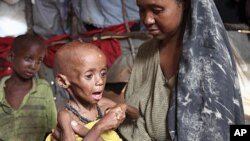The UNHCR continues to work in an emergency mode in Somalia's IDP (Internally Displaced People) camps in preparation of the anticipated October rains. While the famine-stricken country is grappling with malnutrition, disease and displacement, the upcoming rainy season could pose an even further threat to life.
Andy Needham, UNHCR Somalia office spokesperson, said the agency is working to prevent a repeat of what happened in the country in 1992. At that time, about 30,000 people died in September and October during Somalia's famine. He said the deaths were directly attributed to aid agencies being caught off guard by the drought, rains and the drop in temperature that accompanies the rainy season.
“We’re going to give out larger plastic sheets so people can be prepared and to protect themselves from the elements, and from the rain. Also, we’re going to distribute 60,000 blankets so that we can protect young children from the slightly colder weather that will come in October,” said Needham.
Disease
Measles still remains a large concern, especially in Mogadishu. Needham recently visited a hospital in the city and saw many children in hospital wards suffering from the disease.
“Even in the refugee camps, when people make it across the border into Kenya and Ethiopia, we’re seeing measles cases in adolescents, people over fifteen, and even in adults as well,” explained Needham.
The UNHCR spokesperson said his health colleagues are observing lower immune levels in IDPs and refugees.
“The fact that people have trekked for so long, resistance to these types of illnesses is much reduced,” he said.
Still, other challenges exist, such as the ability of aid agencies to move around in Somalia.
“We have to move within security, protocol. So we move with armed, security escorts in areas such as Mogadishu,” said Needham.
As a result, Needham said movements to various IDP settlements are very regimented. Aid workers are forced to travel only at certain times. They do not have the same amount of freedom as aid workers in some of the other refugee camps in the Horn of Africa.










